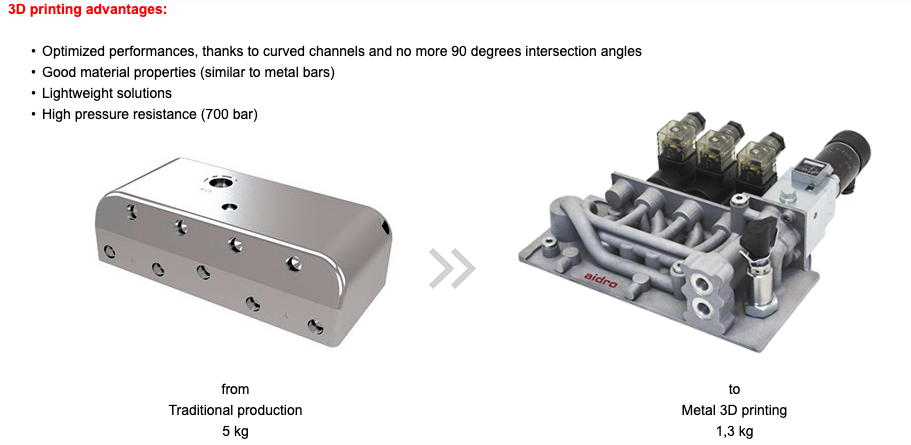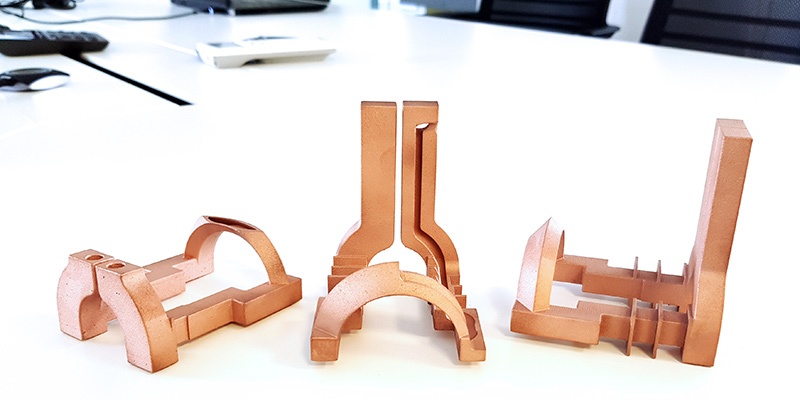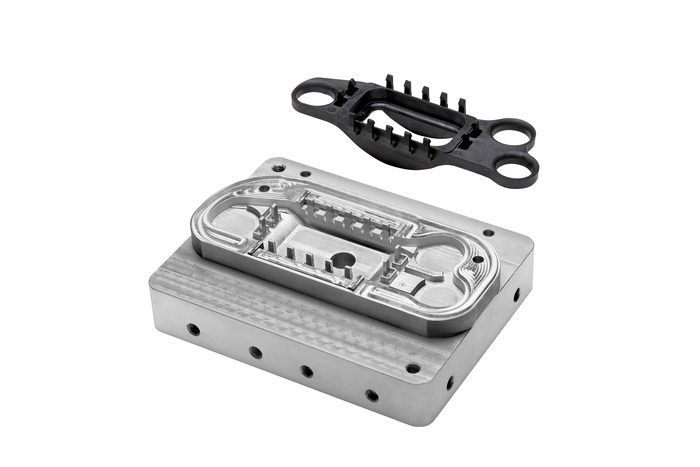3D printing industry news sliced: Stratasys, Sciaky, FIT AG, Essentium, SPEE3D, VELO3D, Sygnis and more
MakerBot launches LABS extruder for METHOD to enable third party engineering material extrusion
The State of 3D Printing in Industrial Goods, Part Two
In the last part of this series, we discussed a variety of general industrial product manufacturers that have begun to adopt 3D printing along the road from prototyping to end part manufacturing. Now, we’ll begin to look at service bureaus that 3D print general industrial goods for their customers. Because there are a number of service bureaus capable of producing parts for industrial product makers, we’ll limit our exploration to just those who market themselves for industrial goods specifically, or are otherwise aligned in such a way that they are already close to the industrial sector.
Kennametal is a tooling and materials supplier that has found a position in the AM space as a metal powders and AM services provider. The company makes powders for metal powder bed fusion (PBF), directed energy deposition (DED) and bound metal 3D printing (think Markforged and Desktop Metal’s desktop metal systems). These materials include gas-atomized cobalt, nickel and iron alloy powders (Stellite, Nistelle and Delcrome).

A 3D-printed valve cage made from Kennametal’s Stellite 6-AM-K powder. Image courtesy of Kennametal.
Kennametal has been 3D printing prototypes and cutting tools for some time, but took things a step further in fall of 2019 with the establishment of a Kennametal Additive Manufacturing business unit. The AM division will help customers through the entire process of securing materials, designing parts for 3D printing, and provide series production relying on binder jetting and PBF. An example component described on the unit’s website is a valve cage 3D printed for IMI Critical Engineering, which supplies flow control systems for industrial processes.
Aidro is an Italian company that makes hydraulic valves and systems for a variety of industries. The firm uses metal PBF to 3D print end-use parts that are up to 85 percent lighter than traditionally made counterparts. Other capabilities developed by Aidro include the ability to combine subcomponents into one single printed unit, improve performance over traditionally made parts, and take up less space than conventionally fabricated components.

A comparison between a traditionally made hydraulic manifold and one redesigned for 3D printing. Image courtesy of Aidro.
HP’s partners GKN Additive and Parmatech will likely play increasingly important roles in AM for the industrial sector through the use of HP’s MetalJet 3D printers. Parmatech is a metal injection molding provider, which focuses on the medical and industrial sectors. Though GKN Additive is somewhat focused on aerospace and automotive parts, given the specialties of its parent company, GKN, it manufactures metal powders for AM and provides 3D printing services more broadly, augmented by its more recent acquisition of Forecast3D.
In particular, the company is tackling copper induction coils, which are used in the automotive and industrial sectors for tempering metal components to make them harder. In addition to allowing for the production of complex, custom copper inductor coils, 3D printing is actually a more repeatable and reliable process for fabricating these parts because the heat treatment phase is built into the production step.
GKN is not alone in this space, however. As niche as the application is, PROTIQ, a subsidiary of German industrial manufacturer Phoenix Contact, has an online configurator for customized copper induction coils, which it can 3D print as a part of is its larger 3D printing services. Additionally, the company offers optimized tooling for injection molding. 3D Inductors is another business that is entirely dedicated to 3D printing copper induction coils.
Though it does not offer its services through an online marketplace, NXCMFG is a service provider that focuses specifically on 3D-printed tooling. Using design and weight optimization, the company is able to 3D print metal molds and inserts with conformal cooling channels that reduce injection molding cycle times between 20 and 80 percent.
In addition to its metal powder production, Swiss engineering conglomerate Oerlikon’s AM division provides 3D printing services. While it can lean on its expertise across a number of verticals, Oerlikon AM boasts 20 years of experience in toolmaking and general industrial products. Examples on its website range from injection molding tools to a heating sleeve and a heating plate with built-in cooling channels and reduced part count.
DM3D is a manufacturer of directed energy deposition (DED) machines that also provides 3D printing services. Like many DED companies, DM3D markets its technology for both part fabrication and repair. This includes pumps for the agricultural industry, hardfacing cutting implements, and high productivity tooling. DED is capable of 3D printing with multiple metals, with which DM3D uses to produce tooling.
Carpenter Technology Corporation (CarTech) is metals company that has been increasing its stake in 3D printing, first by purchasing titanium powder company Puris, then by acquiring an electron beam melting service provider, CalRAM. Along with Proto Labs and Burloak Technologies, an engineering and manufacturing company, the two service providers have become part of the GE Additive’s Manufacturing Partner Network. All three companies perform AM of industrial goods and have expertise related to all forms of manufacturing. This, along with GE’s close ties to the industrial sector, will likely make the entire network an important component in production of industrial parts.
With headquarters in Austria, voestalpine in an important player in the industrial goods sector, providing AM services as a part of its international steel products manufacturing. In addition to developing metal powders for AM, the company has opened a new AM research institute in Taiwan, a production plant in Canada, and an AM center in Singapore. Aside from making products for just about every sector, voestalpine also manufactures molding and tools, highlighting the ability to 3D print molds with built-in conformal cooling.
Through a majority acquisition in AM service provider Materials Solutions, Siemens is now a 3D printing bureau. With a number of EOS metal PBF systems, the company has an established history in metal 3D printing dating back to 2006. Among the sectors it serves, Materials Solutions highlights the 3D printing of tooling from high-temperature super alloys and featuring conformal cooling.
U.K. engineering company Renishaw has its own line of metal PBF 3D printers, as well as Global Solutions Centres in which customers can begin their journey of AM adoption. As a part of this journey, clients can lease Renishaw machines or have parts printed as a service. Along with its expertise across a number of verticals, Renishaw offers 3D printing for industrial tooling and end parts. As we mentioned in our previous installment, Renishaw 3D printed screw-in milling cutters for KOMET Group in Germany.
SMS Group, which recently partnered with Additive Industries for the development of its serial production 3D printers, developers metal powders for AM and offers 3D printing services. Among the parts it has 3D printed for the industrial space are an SIS injector for electric arc furnaces, a PSM roll cooling ring for metalworking, and a 3D-printed multi-nozzle spray head for die maintenance.

Previously welded from 18 different parts, this SIS injector is now made up of a single 3D-printed part and takes up 50 percent less space. Image courtesy of SMS Group.
Jabil is another service provider worth mentioning, given its size and the fact that it is an early adopter of HP’s Multi Jet Fusion (MJF) technology for mass production. After using Ultimaker printer farms in-house for printing jigs and fixtures on its assembly line, the contract manufacturer began using MJF, with HP itself as an early customer. The company 3D prints 50 polymer parts for HP’s printers.
In addition to the companies described here, there are a number of large AM service bureaus that you may already be familiar with that are involved in 3D printing tooling for the industrial sector. These include Stratasys Direct Manufacturing, Protolabs, Xometry, Materialise, Digital Metal, FIT AG and 3D Systems.
In the next installment in this series, we will take a look at some of the 3D printer manufacturers already providing systems for manufacturing industrial goods or primed to take advantage of that sector as it evolves.
The post The State of 3D Printing in Industrial Goods, Part Two appeared first on 3DPrint.com | The Voice of 3D Printing / Additive Manufacturing.
3D Printing Industry Review of the Year May 2019
MakerBot establishes METHOD Materials Program to expand 3D printing filament range
Carbon opens L1 DLS 3D printer to orders, Jabil joins production network
What happened in 3D printing at RAPID & TCT 2019?
Jabil partners with Renault F1 Team to manufacture F1 car parts
Rapid 2019: Interview with John Dulchinos VP 3D Printing and Digital Manufacturing at Jabil
Jabil is a huge contract manufacturing firm that makes and develops products for the brands that you know. With over 100 factories and $22 billion in revenue and over a 200,000 employees Jabil’s interest in 3D printing can have huge ramifications for our industry. Just this one firm could broadly adopt our technology and drive adoption forward. With end-user products having to be made at high volume and low-cost Jabil is not the first firm you may think of when you look at 3D printing. After all, in highly customized industries and high-end applications such as satellites the 3D printing business case is more easily made. Jabil has been doing some fundamentally very interesting things, however. The firm has developed and is making materials which will lower its own costs, it went into the production of footwear and insoles, and set up a 3D printing network while deploying Ultimaker 3D printers and betting big on HP.
Jabil seems to be making a steadfast move in engaging the 3D printing market in a fundamental way. Moreover especially with a global network of manufacturing, a lot of volume, the expertise in making 3D printers itself and its own materials the firm may yet cement significant advantages into the fundamental economics of manufacturing and prototyping. With contract manufacturing being cutthroat and low margin anything that can give them an advantage may have significant knock-on effects. If it makes sense for an automotive manufacturer to adopt 3D printing then it will doubly so make sense for contractors in tight spots on tight deadlines to do so. This is especially true if they can accelerate prototyping, tooling or customization through 3D printing; offer more customized products at lower costs or bridge manufacture more efficiently. Any incremental move towards the ability to do mass customization at scale or to engage in profitable high mix low volume manufacturing could spell doom for competitors.
Heading up Jabil’s considerable 3D printing engagements and investments is VP John Dulchinos. 3DPrint.com spoke with him at RAPID to find out more.

HP printers at Jabil in Singapore
What is Jabil’s strategy in 3D printing?
Our mission is to accelerate the adoption of Additive Manufacturing. We are focused on how do we take an immature solution set and turn it into a manufacturing technology. We want to produce parts in a certified environment. We want to be able to stand behind the parts that we are making.
At the core, we want to make parts. That’s the foundation. This means that we need to engineer materials because there isn’t a good solution set in materials out there for us to use. In 3D printing, you can get any material as long as it is white PA 12 (polyamide). Usually, specific materials are available for specific solutions and in AM this has not been the case. This limitation meant that we had to develop and sell our own materials
What are you doing in AM?
If we look at our clients, they are world-class companies. We work for companies such as HP and Cisco. Top brand companies. At a baseline level, we want to do programs with those companies. In order for us to do that we have to engineer the entire workflow. From the translation in the software to the design file, all of it.
We are interested in aerospace, automative, transportion in general, medical devices, orthopediccs and consumer goods.
Is this contract manufacturing of something else?
Especially for consumer-facing products in things like mass customization application you really need the whole stack to make it make sense. We can do ideation and we can take something from an idea to a solution set.
For us, it is important to understand how and if additive creates value for customers. The more value that there is for them the more possible value there is for us as well.
What are some interesting applications?
I’m an engineer. So I think of it in terms of a logic tree. For a lot of things, 3D printing doesn’t actually make sense. From a cost standpoint it does not map out well when compared to traditional manufacturing. In some low volume applications it makes sense especially in things such as aerospace and spare parts. In aerospace you can, for example, combine parts, save weight. This creates significant value. Late in life parts are also very expensive to keep and produce, here additive also is very usefull. There are many great applications in healthcare as well. Personalized medicine, but broader still also personalized products have much value. In performance, automotive people also want to pay for optimal parts. We can pay for outcomes in additive but that won’t work for all functional production parts.
With Renault F1 now. we are their on demand production partner. We can now supply parts for on the F1 car. We love this since F1 is like we are very engineering driven. This partnership aligns well with us. It fits Jabil’s manufacturing pedigree.
Are you expanding your materials and printers portfolio?
We’ve made a number of materials and want to release a material a month soon. As for printers we operate close to 300 at the moment.
Is 3D printing helping Jabil?
On the design side, for sure 3D printing is speeding up our business. With designs we can now make more iterations. With fixtures and tooling, we are also much faster. We have well documented case studies where we have gone from making a fixture in 4 to 5 weeks in five days. We can also do more quicker iterations in the fixture.
As an anecdotal piece of evidence, we had one fixture used to electrically test a part. It had a slot at the botton through which the operator had to put their hand. Every once in a while the operator’s fingers would slip and touch the circuit board, shorting it. Once this was discovered it took 3 hours to design and two hours to print a solution for this problem. Within five hours we had, thanks to 3D printing, addressed the quality issue.
We also have some really good design for additive examples on recent client projects. In one example we took an existing assembly of 39 parts and reduced it to two. Reduction in assembly processes also happened as a result of this. We used 3D printing to simplify the part and the production process.


